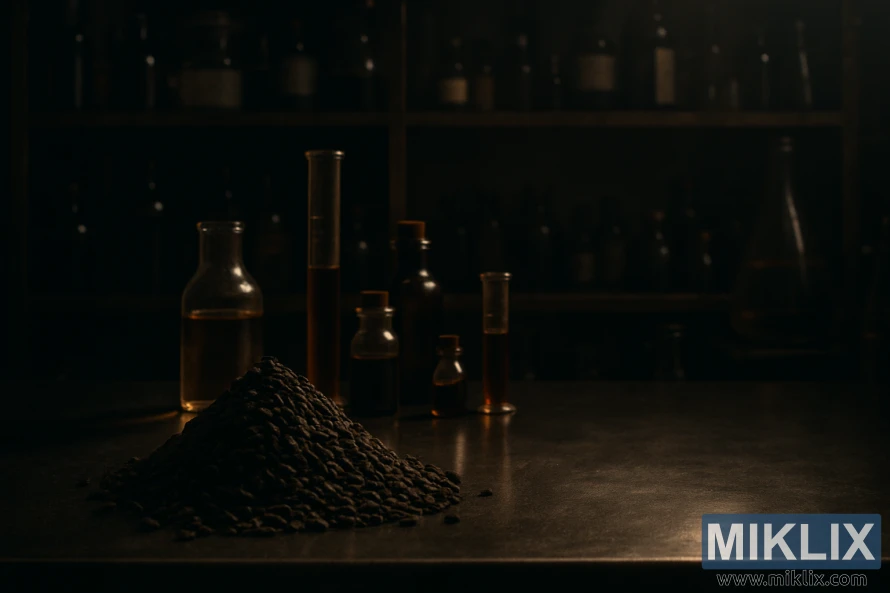Image: Black Malt in Brewing Laboratory
Published: July 29, 2025 at 7:37:07 AM UTC
Last updated: September 27, 2025 at 4:54:24 PM UTC
Dim brewing lab with roasted black malt on steel counter, vials of liquids, and warm light, evoking experimentation and versatile brewing possibilities.
In a shadowed corner of what appears to be a brewing laboratory or apothecary, the image captures a scene steeped in mystery, precision, and artisanal curiosity. The lighting is low and moody, casting warm, amber-toned beams across a steel countertop that gleams with subtle reflections. At the center of this counter lies a pile of dark roasted malt—its texture rugged, its hue nearly black with hints of deep mahogany where the light touches it. The grains are irregular and tactile, their surfaces slightly oily from the roasting process, suggesting a flavor profile that leans into the bold and bitter, with undertones of burnt toast, cocoa, and charred wood.
Surrounding the malt are the tools of experimentation: glass vials, beakers, and test tubes filled with liquids ranging from pale amber to deep copper. These vessels, arranged with deliberate care, hint at a process of infusion, extraction, and blending. Each liquid seems to represent a different stage of development or a unique interpretation of the roasted malt’s potential. Some may be tinctures, others concentrated brews or flavor isolates—each one a testament to the brewer’s or alchemist’s desire to push the boundaries of traditional brewing. The glassware catches the light in delicate glints, adding a sense of refinement and scientific rigor to the otherwise rustic setting.
In the background, shelves line the walls, filled with dark glass bottles whose contents remain unknown. Their uniformity and labeling suggest a catalog of ingredients, perhaps rare spices, botanical extracts, or aged infusions waiting to be called into service. The shelving itself is aged wood, its grain visible beneath the dim light, adding warmth and texture to the otherwise metallic and glass-heavy environment. A haze hangs in the air, possibly steam or the residue of aromatic compounds, softening the edges of the scene and lending it a dreamlike quality. This atmospheric blur creates a sense of depth and distance, drawing the viewer’s eye from the focused foreground into the contemplative recesses of the lab.
The overall mood is one of quiet exploration. It’s a space where tradition meets innovation, where the familiar bitterness of black malt is reimagined through the lens of chemistry and creativity. The juxtaposition of the raw grain with the refined liquids suggests a narrative of transformation—of taking something elemental and coaxing out its hidden dimensions. The steel counter, cold and clinical, contrasts with the organic irregularity of the malt, reinforcing the tension between control and spontaneity that defines the brewing process.
This image doesn’t just depict a brewing setup—it evokes the spirit of experimentation. It invites the viewer to imagine the possibilities: a new style of beer, a malt-infused spirit, a culinary reduction, or even a perfume base. The roasted malt, often relegated to the background of stouts and porters, is here elevated to a central role, its complexity honored and explored. The setting, with its blend of industrial and vintage elements, suggests a place where ideas are tested, flavors are born, and the boundaries of brewing are quietly but persistently expanded.
In this dimly lit laboratory, surrounded by glass, grain, and shadow, the act of brewing becomes something more than production—it becomes a form of inquiry, a dialogue between ingredient and imagination. The roasted malt is not just a component; it is a muse, a challenge, and a promise of flavor yet to be discovered.
The image is related to: Brewing Beer with Black Malt

